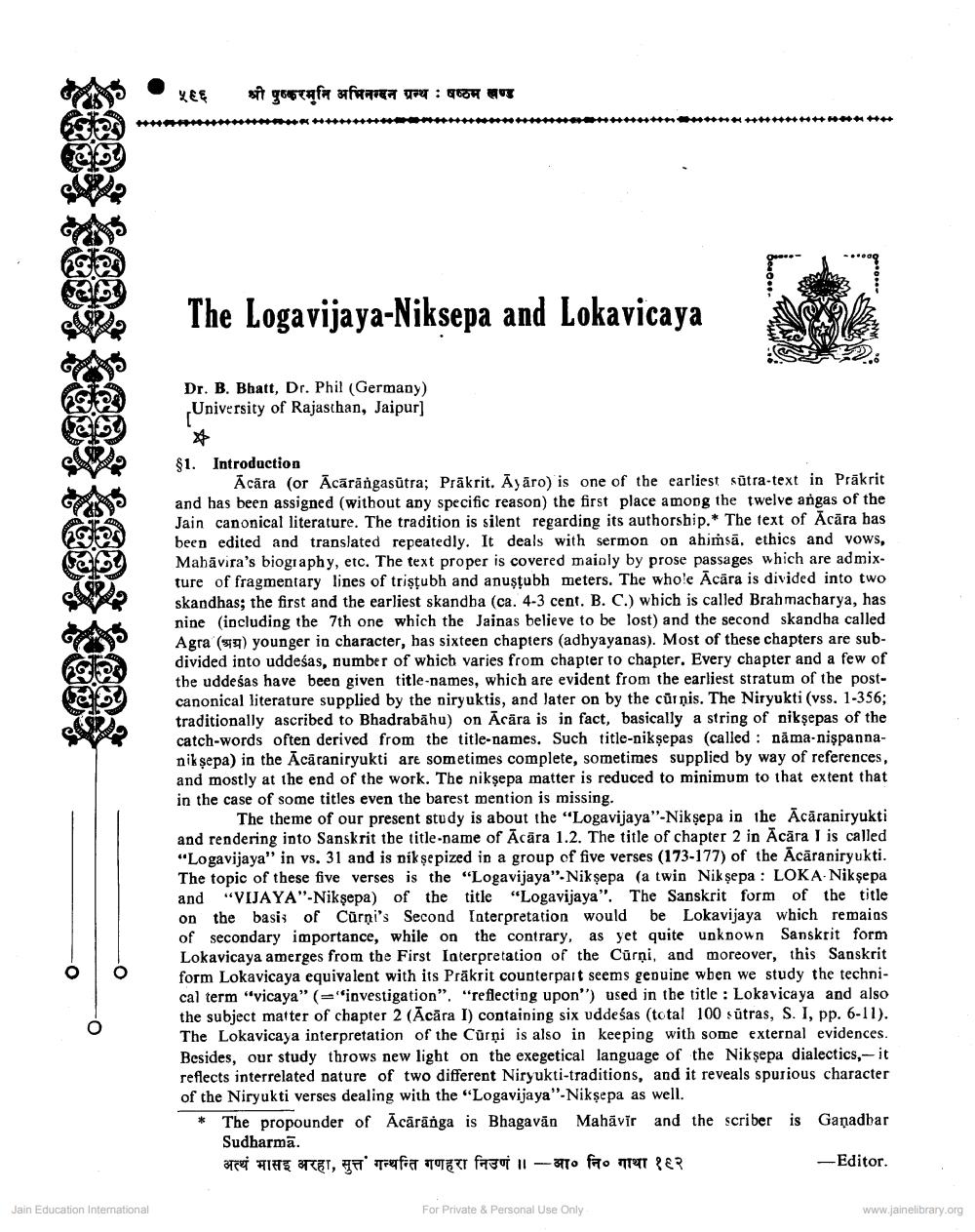Book Title: Logavijaya Niksepa and Lokavicaya Author(s): Bhatt Publisher: Z_Pushkarmuni_Abhinandan_Granth_012012.pdf View full book textPage 1
________________ -O Jain Education International ५६६ श्री पुष्कर मुनि अभिनन्दन ग्रन्थ : षष्ठम खण्ड The Logavijaya-Niksepa and Lokavicaya Dr. B. Bhatt, Dr. Phil (Germany) University of Rajasthan, Jaipur] * §1. Introduction Acara (or Acarängasūtra; Prakrit. Ayaro) is one of the earliest sutra-text in Prakrit and has been assigned (without any specific reason) the first place among the twelve angas of the Jain canonical literature. The tradition is silent regarding its authorship.* The text of Acara has been edited and translated repeatedly. It deals with sermon on ahimsa, ethics and vows, Mahavira's biography, etc. The text proper is covered mainly by prose passages which are admixture of fragmentary lines of triṣṭubh and anuşṭubh meters. The whole Acara is divided into two skandhas; the first and the earliest skandha (ca. 4-3 cent. B. C.) which is called Brahmacharya, has nine (including the 7th one which the Jainas believe to be lost) and the second skandha called Agra () younger in character, has sixteen chapters (adhyayanas). Most of these chapters are subdivided into uddeśas, number of which varies from chapter to chapter. Every chapter and a few of the uddeśas have been given title-names, which are evident from the earliest stratum of the postcanonical literature supplied by the niryuktis, and later on by the cürnis. The Niryukti (vss. 1-356; traditionally ascribed to Bhadrabahu) on Acara is in fact, basically a string of niksepas of the catch-words often derived from the title-names. Such title-nikşepas (called nama-nişpannanik şepa) in the Acaraniryukti are sometimes complete, sometimes supplied by way of references, and mostly at the end of the work. The nikşepa matter is reduced to minimum to that extent that in the case of some titles even the barest mention is missing. The theme of our present study is about the "Logavijaya"-Nikṣepa in the Acaraniryukti and rendering into Sanskrit the title-name of Acara 1.2. The title of chapter 2 in Acara I is called "Logavijaya" in vs. 31 and is nikşepized in a group of five verses (173-177) of the Acaraniryukti. The topic of these five verses is the "Logavijaya"-Nikṣepa (a twin Nikṣepa: LOKA Nik şepa and "VIJAYA"-Nikşepa) of the title "Logavijaya". The Sanskrit form of the title on the basis of Cürni's Second Interpretation would be Lokavijaya which remains of secondary importance, while on the contrary, as yet quite unknown Sanskrit form Lokavicaya amerges from the First Interpretation of the Curni, and moreover, this Sanskrit form Lokavicaya equivalent with its Präkrit counterpart seems genuine when we study the technical term "vicaya" ("investigation". "reflecting upon") used in the title: Lokavicaya and also the subject matter of chapter 2 (Acara I) containing six uddeśas (total 100 sūtras, S. I, pp. 6-11). The Lokavicaya interpretation of the Curni is also in keeping with some external evidences. Besides, our study throws new light on the exegetical language of the Nikşepa dialectics,-it reflects interrelated nature of two different Niryukti-traditions, and it reveals spurious character of the Niryukti verses dealing with the "Logavijaya"-Nikṣepa as well. *The propounder of Acaranga is Bhagavan Mahavir and the scriber is Gaṇadbar Sudharmā. अत्थं मासइ अरहा, सुत्त गन्थन्ति गणहरा निउणं ॥ -आ० नि० गाथा १६२ -Editor. -- *******++++ For Private & Personal Use Only www.jainelibrary.orgPage Navigation
1 2 3 4 5 6 7 8 9 10
